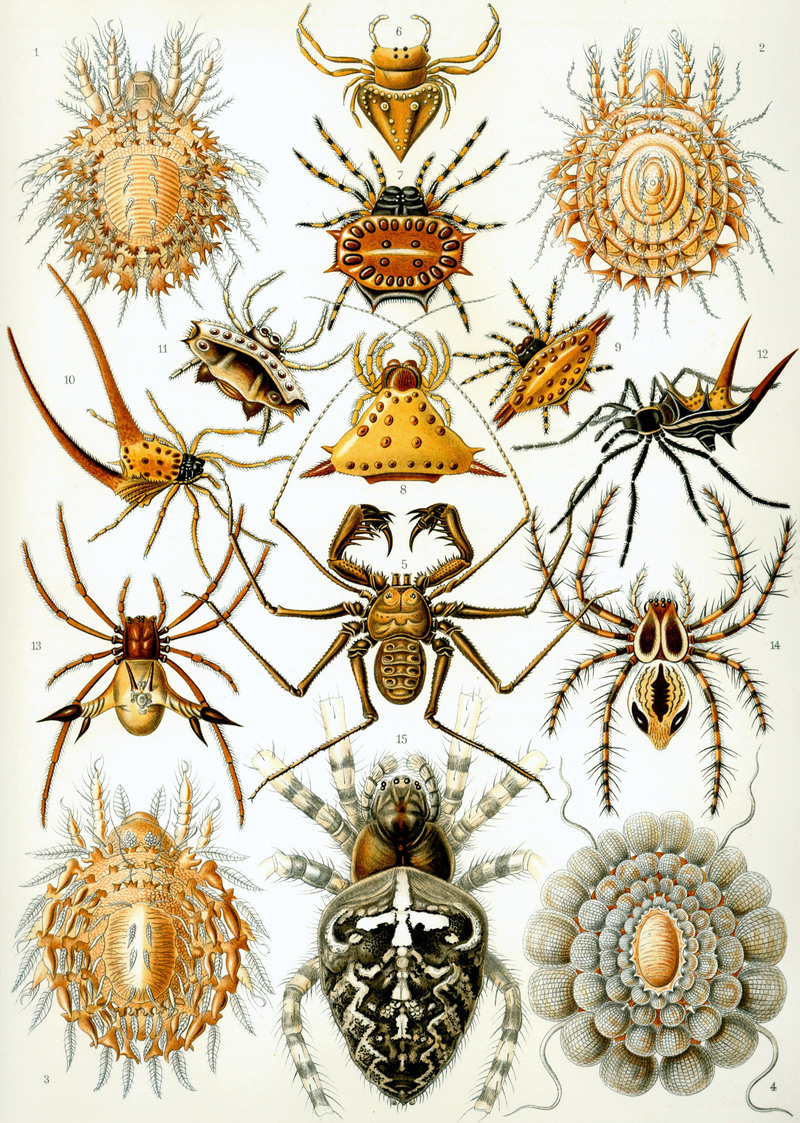|
| Query: Variegatus variegatus | Result: 88th of 93 | |
Kunstformen der Natur: Arachnida
| Subject: | Kunstformen der Natur: Arachnida
| | Poster: | Wiki Photos (---@---.---)
| |

| Resolution: 2369x3326
File Size: 1813109 Bytes
Upload Date: 2017:08:03 16:12:36
|
1: Tegeocranus hericius (Michael) = Protocepheus hericius (Michael, 1887)
2: Tegeocranus latus (Koch) = Cepheus latus C.L.Koch, 1836
3: Tegeocranus cepheiformis (Nicolet) = Cepheus cepheiformis (Nicolet, 1855)
4: Leiosoma palmicinctum (Michael) = Tereticepheus palmicinctum (Michael, 1880)
5: Phrynus reniformis (Olivier) = Phrynichus reniformis (Linnaeus, 1758) / Phrynichus ceylonicus (C.L.Koch, 1843)
6: Arkys cordiformis (Walckenaer) = Gnolus cordiformis (Nicolet, 1849)
7: Gasteracantha cancriformis (Latreille) = Gasteracantha cancriformis (Linnaeus, 1758)
8: Gasteracantha acrosomoïdes (Koch) = Acrosomoides acrosomoides (O. P.-Cambridge, 1879)
9: Gasteracantha geminata (Koch) = Gasteracantha geminata (Fabricius, 1798)
10: Gasteracantha arcuata (Koch) = Macracantha arcuata (Fabricius, 1793)
11: Acrosoma hexacanthum (Hahn) = Gasteracantha cancriformis (Linnaeus, 1758)
12: Acrosoma spinosum (Koch) = Micrathena schreibersi (Perty, 1833)
13: Acrosoma bifurcatum (Hahn) = Micrathena furcata (Hahn, 1822)
14: Oxyopes variegatus (Hahn) (non Latreille, 1806: preoccupied) = Oxyopes ramosus (Martini & Goeze, in Lister, 1778)
15: Epeira diadema (Linné) = Araneus diadematus Clerck, 1757
German:
1: Dornkronen-Moosmilbe (Nymphe). 0,6 mm. Europa.
2: Stachelkranz-Moosmilbe (Nymphe). 0,9 mm. Europa.
3: Gefiederte Moosmilbe (Nymphe). 0,62 mm. Europa.
4: Blattgürtel-Moosmilbe (Nymphe). 1,0 mm. Europa.
5: Nierenförmiger Geißelskorpion. Natürliche Größe. Ostindien.
6: Herzförmige Arkysspinne. 2mal vergrößert. Amerika.
7: Krabbenförmige Stachelspinne. 3mal vergrößert. Brasilien.
8: Dreieckige Stachelspinne. 5mal vergrößert. Madagaskar.
9: Doppeldornige Stachelspinne. 3mal vergrößert. Ostindien.
10: Bogendornige Stachelspinne. 2mal vergrößert. Java.
11: Sechsspitzige Stachelspinne. 4mal vergrößert. Brasilien.
12: Dickdornige Stachelspinne. 2mal vergrößert. Südamerika.
13: Zweigabelige Stachelspinne. 4mal vergrößert. Brasilien.
14: Bunte Springspinne. 3mal vergrößert. Deutschland.
15: Fromme Kreuzspinne. 3mal vergrößert. Deutschland.
Date 1904
Source Kunstformen der Natur (1904), plate 66: Arachnida (http://caliban.mpiz-koeln.mpg.de/haeckel/kunstformen/high/Tafel_066_300.html)
Author Ernst Haeckel (1834–1919)    
Source: https://commons.wikimedia.org/wiki/File:Haeckel_Arachnida.jpg |

|

|

|
Variegatus variegatus
88/93 |

|
 |
^o^
Animal Pictures Archive for smart phones
^o^
|
|